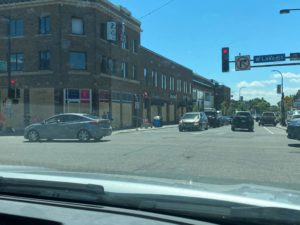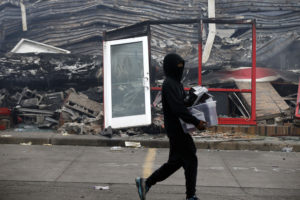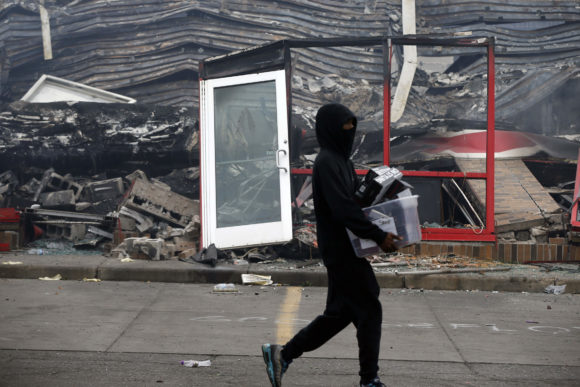Dan Gutlovics did a lot of virtual hand holding during the first days of the violent protests in Minneapolis and St. Paul following the death of George Floyd while in the custody of Minneapolis police on May 25.
Gutlovics, sales executive with Corporate Four Insurance Agency in the Minneapolis suburb of Edina, Minnesota, has commercial insurance clients with businesses in and near the area of Minneapolis that was heavily damaged by the rioting.
Businesses were vandalized and looted, and some were torched during riots that grew out of protests across the country following Floyd’s death.
“Since the beginning of the ordeal, I’ve probably filtered through gosh, 35, 40, phone calls from customers that were either concerned about what their policy and coverage was going to respond to if something happened, to customers calling in the beginning that have had damage, to customers following up with just concern about things in general. It’s been very, very crazy around here,” Gutlovics said.
His agency was not directly impacted by the violence but some of his customers’ businesses were. He said he’s been pouring over his customers’ policies to make sure they have the correct coverages, trying to put them at ease, letting them know they have the proper coverage and letting them know that if they have damages a claim will be filed.
“It’s been a lot of just really trying to help people not have too much fear here in a time where there’s a lot of fear,” he said.
A Deadly Awakening
Minneapolis policeman Derek Chauvin and three other police officers were fired from the Minneapolis Police Department following the incident in which Chauvin pressed his knee on Floyd’s neck for nearly nine minutes while the prone, unarmed, handcuffed man exclaimed that he couldn’t breathe. Chauvin has been charged with second-degree murder without intent, third-degree murder and second-degree manslaughter. The three officers who stood by and watched without attempting to restrain Chauvin have been charged with aiding and abetting second-degree murder.
Days of rioting followed Floyd’s death, not only in Minneapolis and St. Paul but in other cities and towns across the country. The extent of the property damage in the Twin Cities that resulted from the violent protests is still being assessed, but the Star Tribune reported on June 9 that the total cost of the damage could rise above $500 million. It is estimated that nearly 1,000 commercial properties were damaged or destroyed in Minneapolis and St. Paul, according to local news sources.
Damage costs from the recent rioting in the U.S. may rival the 1992 Los Angeles riots to become the most costly civil disorder in the country’s history, insurance experts say. The April and May 1992 civil unrest in Los Angeles following the videotaped police beating of Rodney King caused $775 million in damages — or $1.42 billion in today’s dollars, according to the Insurance Information Institute (I.I.I.).
In Minneapolis, the epicenter of the protests was in the Minneapolis Police Department’s Third Precinct, the headquarters of which was torched and destroyed during the riots. Businesses along Lake Street were severely damaged or destroyed. The Midway region in St. Paul also suffered widespread destruction.
Brian Strub, assistant communications director for the Minnesota Department of Commerce, told Insurance Journal in an email that the department “has not quantified or assessed damage, tallied claims, or made financial estimates or predictions of cost or loss. Local jurisdictions are continuing to conduct damage assessments.”
He said the department is considering the possibility of issuing a data call to insurers regarding claims associated with the protests but that it is too soon to confirm whether that would happen.
“The Minnesota Department of Commerce is working diligently to provide information and resources to affected business owners and residents on how to make insurance claims,” Strub said.
The department also is in contact with officials in Minneapolis and St. Paul, “other state or federal agencies, insurance companies and individual agents, chambers of commerce, neighborhood and other local groups and consumers impacted.”
Coverage Issues
Gutlovics said after the first night of protests he got a call from one of his clients who owns a pizza restaurant, not on Lake Street but nearby. The owner had boarded up the restaurant’s windows but the protesters “took the boards down, busted the windows, and ultimately ended up breaking in and looting the place,” Gutlovics said.
He told his client initially not to try to clean up or make repairs because it appeared that there would be more uncertainty and unrest, and there was. There was “no point in trying to clean up or fix something up at this point because we don’t know what’s going to happen,” he said.
Another one of Gutlovics’ customers “has a restaurant on Lake Street and they were also impacted that first night,” he said. The next night, rioters came back and burned the same building down. “Basically, it’s not a normal claim where you’re like, ‘Okay, let’s get started here and get you back up and running.’ It’s a situation where we don’t know when this is going to stop, so there’s no point in doing anything right now, except sit and wait and hopefully things calm down over the next couple of days,” Gutlovics said.
So, his initial advice to impacted clients in the beginning days of the protests was to hold tight, board up and “try to keep them from coming back and burning your place down. … It was a real different way of thinking than our normal claims process.”
Damage from the protests in most cases “will be a covered event for businesses and homeowners throughout the U.S. The types of claims that are anticipated include physical property damage to facilities, including glass, windows, doors, light fixtures, furniture and merchandise; as well as commercial and personal vehicles. Residential property loss claims are also possible,” said Mark Friedlander, director of Corporate Communications for the I.I.I.
Gutlovics said most of the impacted businesses in his book have standard business owners policies or a package policy that provides coverage for property and liability.
His customers whose businesses suffered physical damage are going to be covered not only for property damage but because their properties were impacted physically, they will have met the trigger for loss of income as well.
What’s not so clear is what kind of coverage businesses that boarded up and shut down voluntarily in order to stave off losses will have, he said.

In addition, many businesses, including those with direct physical losses from the riots, were already closed or had limited business due to the civil authority-ordered shutdowns prompted by the coronavirus pandemic.
“Unfortunately, unless you’ve had a physical damage, which is the trigger for insurance, they’re not going to be able to collect under their insurance policy,” Gutlovics said.
Around 40 percent of the nation’s small to medium sized businesses carry business interruption coverage, according to the I.I.I.’s Friedlander. It “would typically cover business income losses incurred as a result of a riot, civil commotion and vandalism. Even if the business was still shut down or operating at limited capacity due to the impacts of the COVID-19 pandemic, most insurers will determine income loss based on a 12-month assessment of the operation’s income,” he said.
Gutlovics wondered, however, how the business owners and BI policies will apply in cases where there was a widespread curfew enforced due to the rioting but the actual physical damage to buildings was concentrated in a few areas.
Typically, civil authority coverage is applicable in cases where there might be a bomb threat or a big fire, for instance, where the government closes down the area and prevents customers from coming to that location, he said.
In the Lake Street district, “there was evidence of physical damage to structures in that neighborhood.” At this point, however, he said he wasn’t sure if a widespread curfew in and of itself would trigger coverage for all businesses that were forced to shut down. “Basically, it was a curfew that they put into place, right, that said everybody has to be shut down. … All the suburbs, everybody was subject to this. I don’t think that’s going to trigger civil authority coverage, but it’s still a little bit too early to tell how the adjusters are going to evaluate that,” Gutlovics said.
The main message he’s been getting from insurance carriers in response to the riot damage is that they are temporarily placing a moratorium on the binding or changing of coverage in the impacted areas. They are “saying at this point in time, ‘We’re not allowing for any additional changes to policyholders in the affected area.'”
The alarming civil unrest of late May and early June has sparked his clients’ interest in what exactly their policies cover, Gutlovics said. As a result, he’s having a lot of conversations with customers about what coverages they have and whether they need to increase or modify their policies to better protect their business assets when the carriers regain their appetite for writing business in the impacted areas.

Kimberly Winter heads up the insurance recovery and counseling group at the law firm, Lathrop GPM LLP. Winter is based in Kansas City, but the firm has offices all over the U.S., including Minneapolis.
Business policies “are not cookie cutter,” Winter said. There are “different forms and versions and people need to really look at their policies closely to understand what their coverage rights are.”
For the business interruption trigger, some sort of direct physical loss is required. However, some courts have interpreted some of the nuanced policy language to mean that “loss of use of that property is sufficient,” in cases where a civil authority mandate forces a business to close.
“A lot of insurance companies are denying coverage business interruption due to COVID-19 because they have virus exclusion or because they’re saying it’s not direct physical loss, which is debatable,” Winter said.
The COVID-19 situation adds “an extra wrinkle here because undoubtedly the insurance companies are just going to say, well, you wouldn’t have had any business anyway,” she said. A policyholder “may get coverage for any physical property damage to [their] business arising out of the fallout from the protest but [insurers] may push back much harder about any type of business interruption because of the complication of the COVID-19 business interruption.”
Agents, Winter said, can really help their customers by looking at all the policies that might apply and by not overlooking overlapping coverage. It’s also important to make sure to put carriers on notice “sooner rather than later, even if you don’t have all the details about the damages.”
There may be “pretty quick deadlines to file a claim or you might lose your coverage. So that’s important,” she said.
Recovery Efforts
Not all businesses that have been impacted by the riots have the resources to adequately recover. Some are uninsured or underinsured.
Minneapolis’ Lake Street area is known traditionally “as a community that’s a little bit underserved [with] a lot of ethnic businesses and so forth there. And there is a concern that there are a number of businesses there that might not have had insurance or the proper insurance,” Gutlovics said. Plus, “a lot of them were struggling with already down businesses from COVID. … That is going to be a concern, I think, for the hardest-hit area here.”
The good news at there are efforts being made by both private and public organizations to help the areas and the businesses impacted by the riots. “For those that may not have proper insurance coverage, it does look like there are people out there that are anticipating this and have been trying to set up some fundraisers for them,” Gutlovics said.
In a press conference held by Minnesota Gov. Tim Walz on June 1, Minneapolis Mayor Jacob Frey said the city “knew starting with COVID-19 that we were going to need to help businesses recover in some form from a fiscal standpoint after the economy began to reopen. Now, in addition to helping from a fiscal standpoint, we have entire corridors in Minneapolis where buildings have been destroyed. We need to have help to replace those buildings and get people back on track. I know that the governor and [Saint Paul Mayor Melvin Carter] are committed to helping provide that necessary support.”
Businesses in these hard-hit areas are barber shops, grocery stores, “mom and pop shops that are going to need substantial help … and I can say that we are committed to it,” Frey said.
Frey has since announced that the newly created Minneapolis Forward: Community Now Coalition, which includes representatives of local business and community groups, would work with the residents and business owners of the impacted areas to make sure the recovery efforts accommodate the needs of their community.
Related:
- Riots in Wake of Floyd’s Death Could Become Most Costly Civil Disorder for Insurers
- Did Debate Over Business Income Insurance Just Get More Complicated?
- Businesses Hurt First by Coronavirus Then by Looting Have New Insurance Questions
Topics Carriers Agencies Profit Loss Claims Talent Law Enforcement Property Minnesota
Was this article valuable?
Here are more articles you may enjoy.



 Progressive Gains as Drivers Shop Around for Auto Insurance—Again
Progressive Gains as Drivers Shop Around for Auto Insurance—Again  JPMorgan Client Who Lost $50 Million Fortune Faces Court Setback
JPMorgan Client Who Lost $50 Million Fortune Faces Court Setback  Investment Funds File New Suits Over Lighthouse Insurance Collapse in 2022
Investment Funds File New Suits Over Lighthouse Insurance Collapse in 2022  Survey Shows Majority of Florida, California Homeowners Seeing Higher Insurance Costs
Survey Shows Majority of Florida, California Homeowners Seeing Higher Insurance Costs 

